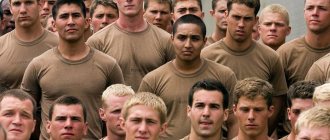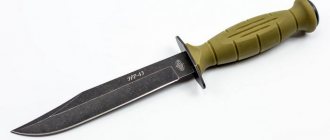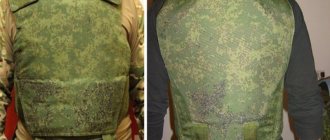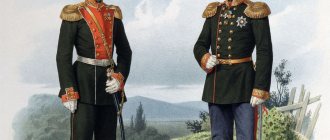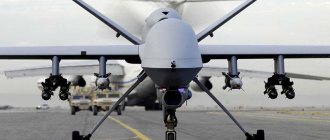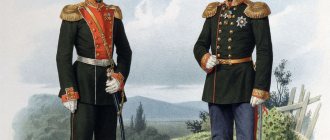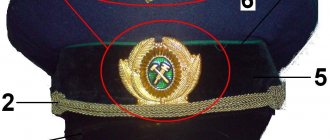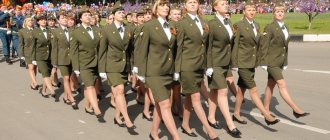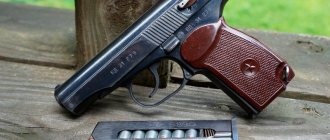The successful implementation of any military campaign depends on the availability of information about the enemy’s forces, their weapons and numbers. Since ancient times, before the start of a large-scale offensive, detachments of spies were formed from volunteers and infiltrated into enemy territory to collect data or carry out sabotage. The development of weapons and the enrichment of military experience have improved the methods of conducting reconnaissance and sabotage work and served as an impetus for the creation of various paramilitary formations, each of which performs its own highly specialized task.
What is it intended for and how does it work?
Army special forces of different countries, with differences in the specifics of training, weapons and camouflage, have one task assigned to them - the quick and silent elimination of the enemy.
For this purpose, the most vital organs of the enemy are affected, which eliminates any possibility of resistance and guarantees instant death.
Army special forces in their work use camouflage techniques that have certain differences in units of different countries. It all depends on the environment, characteristic of a particular area, weather and seasonal conditions in which you have to operate. Based on this, army special forces are equipped with a special uniform adapted to the colors of the terrain and special equipment for firearms - silencers and flame arresters, allowing them to be freely used behind enemy lines, without fear of giving themselves away by the sounds of gunfire or flashes of flame.
Special forces units carry out reconnaissance work, regardless of environmental conditions and the situation in the enemy camp. The end result is considered to be the information obtained about the enemy’s weapons, his numbers, and the characteristics of the terrain on which further open combat operations will take place.
SPN GRU
These special forces were created in 1950 under the General Staff. According to official data, the total number of all mobile combat groups and detachments operating today exceeds 10 thousand people. The responsibilities of the GRU special forces include organizing reconnaissance activities and sabotage on enemy territory in conditions of military conflict.
In peacetime, special forces are tasked with carrying out secret special missions. The GRU special forces are armed with Mi-8 AMTSH Terminator military helicopters, Tiger armored vehicles and personal firearms with silencers.
Special forces took part in operations during the Afghan war, in Chechnya, Georgia (2008) and Syria.
What information does the special forces obtain?
Reconnaissance conducted by special forces is considered effective if it is able to provide the army leadership with the necessary information:
- Information about the enemy.
This is information about the topographical location of those objects that are subject to capture, and an assessment of the degree of their security. The report must contain data on the quantity, quality and location of enemy fire weapons, on the possible proximity of reserve combat units, on the distance from them to captured objects, on the time and methods of approach of enemy reserves in the event of a direct combat clash.
- Location data.
The report contains information about the passability of the territory, the presence of natural obstacles (gorges, reservoirs), their nature and the possibility of overcoming them. This also includes data on populated areas, which must be taken into account in order to ensure a discreet approach to the capture objects of interest.
History of creation
In order to identify, neutralize and eliminate terrorist groups, carry out sabotage and counter-terrorist combat missions behind enemy lines, the Russian Federation uses special combat units and units of the special services, armed forces and police.
Russian special forces have their own history.
On July 29, 1974, Directorate “A” was formed in the USSR, which until 1991 belonged to the seventh directorate of the KGB. This unit is still active today. This is a special counter-terrorist unit “A” of the FSB, known to everyone as the “Alpha” special forces, recognized in the world as one of the most effective.
In 2011, the team of Detachment “A” under the FSB of Russia participated in the world championship of special forces, where they received the first two places and were recognized as the best international team.
Health requirements
As noted above, to serve in special forces, a girl must be in excellent health. The requirements for it are approved by the relevant regulatory legal acts. For example, by Order of the FSB of Russia No. 39 of January 29, 2015, for persons entering this department under a contract.
To enter the service, candidates must pass a military medical commission. The purpose of the medical examination is to check the state of health, identify diseases or injuries that prevent entry into special forces.
For example, as part of the VVC, standard examinations of vision, nervous system and musculoskeletal, hearing, skin, and so on are carried out. Diagnostic examinations are also carried out, for example, a general blood test is taken, a cardiogram is taken and fluorography is performed. Only after a total examination will a citizen be assigned one of five categories that corresponds to his state of health.
In particular, it may be recognized:
- fit for service without any restrictions (A) ;
- fit for service, but with minor restrictions (B) ;
- limited fit for service (C) ;
- temporarily unfit for service (G) ;
- unfit for military service (D) - this group is established if a person has serious injuries, chronic illnesses, or is disabled, according to the ITU conclusion. Such a person is not suitable for service either for special forces or for any other unit.
Typically, the most common reason for assigning a category D to a candidate is a visual impairment, such as glaucoma or color blindness. If a woman is found to be pregnant, she will be declared temporarily unfit (G) by the commission for service in a special forces unit.
It should be noted that in order to get into the special forces, a girl, based on the results of the military military examination, must receive a conclusion that she is fit for service without restrictions.
Special forces: division “A”. Functions
Its main task is to carry out specific military security measures to search and identify terrorist organizations, neutralize and further destroy armed criminals. Alpha special forces are engaged in the release of hostages and negotiations with terrorists. The detachment is intended to seize aircraft and water vessels, ground transport and storm buildings with hostages held there. The services of Detachment “A” are often used during riots in prisons and colonies, since the unit is considered elite and is highly effective. This made it in demand when carrying out military operations in “hot spots” and in other situations that are complicated or out of control.
SOBR
Mobile special forces units, which today belong to the Russian Guard, were formed in 1992. According to preliminary estimates, the total number of SOBR fighters today exceeds 25 thousand people.
Their primary tasks are planning and conducting special operations to free hostages, counteracting riots on the streets, capturing and neutralizing criminal gangs, and providing forceful support to the police.
The riot police use automatic weapons, water cannons (to disperse demonstrators), protective shields, rubber batons and tear gas canisters. Also, service dogs often take part in operations along with SOBR soldiers.
World analogues
Such a special unit is not the only one in the world. American special forces have shown high effectiveness in the fight against terrorism. Good material support for the groups made it possible to conduct numerous experiments, which allowed them to achieve high results. During an assault on fortified buildings, fighters from such detachments penetrate inside unexpectedly for terrorists - at points that, unlike door and window openings, are not controlled by them. This significantly reduced the mortality rate in American special forces.
Almost all developed countries have similar anti-terrorism units, which differ little from each other. They also perform the function of anti-terrorism in their state and their tactics are similar.
About combat training
Completing tasks requires enormous physical and psychological stress from each special forces soldier. This is due to the fact that the special forces detachment carries out its functional tasks primarily either behind enemy lines, or in terrain completely unsuitable for normal human life.
Staying in an extreme environment, in harsh conditions, without communication with the outside world requires each participant in the special forces to have physical and psychological health, fitness and moral readiness to withstand possible stress.
Many feature films, documentaries and TV series have been made about the airborne special forces, which colorfully show how effectively and efficiently the special squad works. But behind the side visible to the audience, there is another, which consists of daily and tedious briefings and training, high demands placed on the fighters by their leadership.
Special forces training is carried out under the supervision of experienced instructors. The purpose of the training is to transfer knowledge to the wards and develop in them the practical skills necessary to perform combat missions. During the exercises, fighters are taught both standard and highly specialized skills.
What does special forces training include?
1. Standard skills:
- hand-to-hand combat;
- fire, psychological and general physical training.
2. Highly specialized knowledge and practical skills:
- silent movement behind enemy lines, which includes the ability to covertly overcome water and engineering barriers, swamps, and navigate the terrain at night;
- performing tasks for observation and collection of information in urban environments and populated areas;
- effective camouflage: the special forces uniform is selected for the soldiers depending on the conditions of the terrain in which the work is being carried out - it can be mountains, forests, desert, swampy terrain or a surface covered with snow;
- orientation on the ground both with the help of a topographic map and without it, the ability to notice and distinguish traces;
- the ability to carry out radio reconnaissance and use other means of technology for this purpose;
- survival skills in difficult conditions for the human body;
- psychological training and obtaining the knowledge necessary to provide emergency medical assistance.
Excerpt characterizing Russian Special Forces (newspaper)
“Nothing,” said the Countess. - It's ready, let's go. – And the countess bent down to her reticule to hide her upset face. Sonya hugged Natasha and kissed her. Natasha looked at her questioningly. - What you? What happened? - Nothing... No... - Very bad for me?.. What is it? – asked the sensitive Natasha. Sonya sighed and did not answer. The Count, Petya, m me Schoss, Mavra Kuzminishna, Vasilich entered the living room, and, having closed the doors, they all sat down and sat silently, without looking at each other, for several seconds. The count was the first to stand up and, sighing loudly, began to make the sign of the cross. Everyone did the same. Then the count began to hug Mavra Kuzminishna and Vasilich, who remained in Moscow, and, while they caught his hand and kissed his shoulder, he lightly patted them on the back, saying something vague, affectionately soothing. The Countess went into the imagery, and Sonya found her there on her knees in front of the images that remained scattered along the wall. (The most expensive images, according to family legends, were taken with them.) On the porch and in the courtyard, the departing people with daggers and sabers with which Petya had armed them, with their trousers tucked into their boots and tightly belted with belts and sashes, said goodbye to those who remained. As always during departures, much was forgotten and not properly packed, and for quite a long time two guides stood on both sides of the open door and steps of the carriage, preparing to give the Countess a ride, while girls with pillows, bundles, and carriages were running from home to the carriages. , and the chaise, and back. - Everyone will forget their time! - said the countess. “You know that I can’t sit like that.” - And Dunyasha, gritting her teeth and not answering, with an expression of reproach on her face, rushed into the carriage to redo the seat. - Oh, these people! - said the count, shaking his head. The old coachman Yefim, with whom the countess was the only one who decided to ride, sitting high on his box, did not even look back at what was happening behind him. With thirty years of experience, he knew that it wouldn’t be long before they told him “God bless!” and that when they say, they will stop him two more times and send him for forgotten things, and after that they will stop him again, and the countess herself will lean out of his window and ask him, by Christ God, to drive more carefully on the slopes. He knew this and therefore more patiently than his horses (especially the left red one - Falcon, who kicked and, chewing, fingered the bit) waited for what would happen. Finally everyone sat down; the steps gathered and they threw themselves into the carriage, the door slammed, they sent for the box, the countess leaned out and said what she had to do. Then Yefim slowly took off his hat from his head and began to cross himself. The postilion and all the people did the same. - With God blessing! - said Yefim, putting on his hat. - Pull it out! - The postilion touched. The right drawbar fell into the clamp, the high springs crunched, and the body swayed. The footman jumped onto the box as he walked. The carriage shook as it left the yard onto the shaking pavement, the other carriages also shook, and the train moved up the street. In the carriages, carriages and chaises, everyone was baptized at the church that was opposite. The people remaining in Moscow walked on both sides of the carriages, seeing them off. Natasha had rarely experienced such a joyful feeling as the one she was experiencing now, sitting in the carriage next to the countess and looking at the walls of an abandoned, alarmed Moscow slowly moving past her. She occasionally leaned out of the carriage window and looked back and forth at the long train of wounded preceding them. Almost ahead of everyone, she could see the closed top of Prince Andrei's carriage. She did not know who was in it, and every time, thinking about the area of her convoy, she looked for this carriage with her eyes. She knew she was ahead of everyone. In Kudrin, from Nikitskaya, from Presnya, from Podnovinsky, several trains similar to the Rostov train arrived, and carriages and carts were already traveling in two rows along Sadovaya. While driving around the Sukharev Tower, Natasha, curiously and quickly examining the people riding and walking, suddenly cried out in joy and surprise: “Fathers!” Mom, Sonya, look, it’s him! - Who? Who? - Look, by God, Bezukhov! - Natasha said, leaning out of the carriage window and looking at a tall, fat man in a coachman’s caftan, obviously a dressed-up gentleman by his gait and posture, who, next to a yellow, beardless old man in a frieze overcoat, approached under the arch of the Sukharev Tower. - By God, Bezukhov, in a caftan, with some old boy! By God,” said Natasha, “look, look!” - No, it’s not him. Is it possible, such nonsense? “Mom,” Natasha shouted, “I’ll give you a beating that it’s him!” I assure you. Wait, wait! - she shouted to the coachman; but the coachman could not stop, because more carts and carriages were leaving Meshchanskaya, and they were shouting at the Rostovs to get going and not delay the others. Indeed, although already much further away than before, all the Rostovs saw Pierre or a man unusually similar to Pierre, in a coachman's caftan, walking down the street with a bowed head and a serious face, next to a small beardless old man who looked like a footman. This old man noticed a face sticking out of the carriage at him and, respectfully touching Pierre's elbow, said something to him, pointing to the carriage. For a long time Pierre could not understand what he was saying; so he was apparently immersed in his thoughts. Finally, when he understood it, he looked as directed and, recognizing Natasha, at that very second, surrendering to the first impression, quickly headed towards the carriage. But, having walked ten steps, he, apparently remembering something, stopped. Natasha’s face, sticking out of the carriage, shone with mocking affection. - Pyotr Kirilych, go! After all, we found out! It is amazing! – she shouted, holding out her hand to him. - How are you? Why are you doing this? Pierre took the outstretched hand and awkwardly kissed it as he walked (as the carriage continued to move). - What's wrong with you, Count? – the countess asked in a surprised and compassionate voice. - What? What? For what? “Don’t ask me,” Pierre said and looked back at Natasha, whose radiant, joyful gaze (he felt this without looking at her) filled him with its charm. – What are you doing, or are you staying in Moscow? – Pierre was silent. - In Moscow? – he said questioningly. - Yes, in Moscow. Farewell. “Oh, I wish I were a man, I would certainly stay with you.” Oh, how good it is! - Natasha said. - Mom, let me stay. “Pierre looked absentmindedly at Natasha and wanted to say something, but the countess interrupted him: “You were at the battle, did we hear?” “Yes, I was,” answered Pierre. “Tomorrow there will be a battle again...” he began, but Natasha interrupted him: “What’s the matter with you, Count?” You don’t look like yourself... - Oh, don’t ask, don’t ask me, I don’t know anything myself. Tomorrow... No! Goodbye, goodbye,” he said, “a terrible time!” - And, falling behind the carriage, he walked onto the sidewalk. Natasha leaned out of the window for a long time, beaming at him with a gentle and slightly mocking, joyful smile. Pierre, since his disappearance from home, had already been living for the second day in the empty apartment of the late Bazdeev. Here's how it happened. Waking up the day after his return to Moscow and meeting with Count Rostopchin, Pierre for a long time could not understand where he was and what they wanted from him. When he was informed, among the names of other people who were waiting for him in the reception room, that a Frenchman was also waiting for him, bringing a letter from Countess Elena Vasilievna, he was suddenly overcome by that feeling of confusion and hopelessness to which he was capable of succumbing. It suddenly seemed to him that everything was over now, everything was confused, everything had collapsed, that there was neither right nor wrong, that there would be nothing ahead and that there was no way out of this situation. He, smiling unnaturally and muttering something, then sat on the sofa in a helpless position, then stood up, went to the door and looked through the crack into the reception area, then, waving his hands, returned back, I took up the book. Another time, the butler came to report to Pierre that the Frenchman, who had brought a letter from the countess, really wanted to see him even for a minute and that they had come from the widow of I. A. Bazdeev to ask to accept the books, since Mrs. Bazdeeva herself had left for the village.
Tasks and structure of the Russian Navy
During martial law, the naval special forces of the Russian Federation are engaged in:
- mining ships, militarized naval bases and hydraulic structures of the enemy;
- search for and further physical destruction of enemy weapons intended for nuclear attack and the points that carry out their operational control;
- detection of other enemy objects and accumulations of manpower in the coastal zone;
- providing landing operations in the coastal zone;
- directing and adjusting air and naval artillery strikes against identified enemy forces.
In peacetime, Russian naval special forces are engaged in the fight against terrorism and exchange experience with other special forces.
The staff of the naval special squad includes 124 people - 56 of them are fighters, the rest are technical personnel. The fighters in the squad are divided into units and act autonomously. Each of these groups consists of 12 people. They are divided into groups of 6 people: an officer, a midshipman and four sailors.
The Russian naval special forces are represented by three detachments, each of which performs its own task:
- The first detachment is intended to destroy enemy targets located on land. The detachment's tactics consist of a discreet underwater approach to targeted enemy targets with further sabotage. The fighters act as divers and act on the spot as saboteurs of the Main Intelligence Directorate.
- The second detachment is engaged in reconnaissance work.
- The third detachment of naval special forces carries out underwater mining of ships, naval bases, manpower locations and other important enemy targets. The detachment's fighters train especially intensively for the role of combat divers, since they operate primarily not on land, but under water - they conduct sabotage work and carry out attacks.
Notes
- [www.specnaz.ru/article/?1685 Russian Special Forces ||| Association ||| Knight of Anti-Terror]
- [www.specnaz.ru/pozicii/81/ SPECIAL FORCES OF RUSSIA ||| POSITIONS ||| 10 YEARS OF THE ALPHA ASSOCIATION IS JUST THE BEGINNING]
- ↑ 12
[www.alphagroup.ru/press-service/news/1913 Personnel appointments at Alpha] - ↑ 12
[www.specnaz.ru/article/?1686 Russian Special Forces ||| Association ||| Personnel Appointments at Alpha] - [www.specnaz.ru/article/?1742 Russian Special Forces ||| Association ||| Awarded Posthumously]
- [monarchruss.org/index.php?option=com_content&task=view&id=852&Itemid=27 All-Russian Monarchical Center - Jerusalem Cross to the Vice President of Alpha. Posthumously]
Internal troops of the Ministry of Internal Affairs of Russia
In the Russian Federation, these troops belong to and are subordinate to the Ministry of Internal Affairs. Following the law “On Internal Troops”, the special forces of the Internal Troops perform the following tasks:
1. In peacetime:
- ensure public order;
- carry out protection of nationally important objects and cargo during transportation;
- release hostages;
- help other units of the Ministry of Internal Affairs in the fight against crime.
2. In wartime and in an emergency situation, in accordance with a certain law “On Internal Troops,” the special forces of the Internal Troops receive additional responsibilities - providing assistance to border security forces in ensuring the territorial defense and security of the country, protecting the state’s borders.
Features of the work of special forces in urban conditions
To carry out combat missions in populated areas, Russian special forces use the following equipment:
- overcoming obstacles;
- covert inspection of the area;
- silent penetration into the building;
- fast and effective storming of buildings;
- clearing occupied buildings.
1. Overcoming obstacles in urban areas. The work is carried out after a thorough examination of the situation. Before overcoming an obstacle along the way, special forces soldiers inspect the territory for the possible presence of a hidden enemy. Before overcoming the wall, its opposite part is inspected.
2. Inspection of the urban area. Buildings are ideal for this task; observation is recommended from behind their corners. The main thing is to do this carefully, without revealing yourself with weapons or equipment.
3. When entering a building, window openings pose a particular danger; you must move under them at a fast pace and bend low. The fighter must be below the level of the window cut. It is recommended to step over window openings in semi-basements.
4. During the assault, the advance of the special forces is carried out along the walls, and also involves passing through them, using faults and cracks. Doorways are overcome by throwing under the cover of fire from a partner. The throw should be made quickly and immediately aimed under cover.
Russian special forces, like special forces of other countries, use smoke screens in addition to fire cover when crossing open terrain. In this case, dashes are made from one shelter to another if there is a small distance between them. Such advancement is carried out by a group with a mandatory interval between fighters of at least ten steps. This distance will prevent possible fire damage.
During an assault, American special forces use means that allow them to destroy walls in a captured building in places that are not controlled by armed criminals. The unexpected appearance of special forces soldiers in a hole formed in the wall has an overwhelming effect on terrorists - the effect of surprise is triggered. A moderate explosion, knocking out bricks and cinder blocks strictly along a certain contour, stuns an enemy unprepared for such an assault.
In Russian special forces, a building is stormed immediately after a grenade is thrown into a window opening. The disadvantage of this kind of capture tactic is that the enemy can quickly react and throw it back. In this case, there is a high risk of being hit by fragments of one’s own exploding shell.
5. Clearing the captured building. After the assault, the building is subject to thorough inspection. For this purpose, one fighter takes a firing position outside the doorway and covers the group. Premises that have passed the inspection are marked with a symbol. The special forces clear the area by moving along flights of stairs from top to bottom. This allows you to “push” the enemy to the lower floors, where it is easier to destroy him or push him out into the street and detain him. It is undesirable to clean from bottom to top. This will give the enemy a chance to gain a strong foothold on the upper floors or escape along the roofs of nearby buildings.
FIZO standards
In order to join the FSB or the special forces of another security agency, all candidates must fulfill physical training requirements. At the same time, each department has its own standards. Thus, the required level of physical training for joining the FSB units was approved by FSB Order No. 253 dated April 14, 2016 in Appendix No. 1.
Table No. 1. Selective exercises for women designed to test every quality - speed, strength and endurance - required to win a contract.
| 1) Strength: | 2) Speed: | 3) Endurance: |
|
|
|
For comparison, men are offered, among other things, bench press and pull-ups.
By the way , it should be borne in mind that each exercise is assessed for speed or number of repetitions. For example, 100 points can be obtained for running 60 m in 8.8 seconds, 100 m in 14.8 seconds, and 1 km in 3 minutes 40 seconds. The maximum number of points can be earned by performing a complex strength exercise 46 times. Detailed indicators for women are approved in Appendix No. 2 of FSB Order No. 253.
The standards for admission to contract service in units of the Armed Forces of the Russian Federation, including special forces, physical training requirements are established by Order of the Ministry of Defense of the Russian Federation No. 200 dated April 21, 2009 in Appendix No. 20.
Table No. 2. Women need to choose from one of the exercises to test each of the qualities.
| Exercises | Requirements for female military personnel | |
| Up to 25 years | After 25 years | |
| Force | ||
| Bending and extending the arms from a lying position | 12 times | 10 times |
| Bend the torso forward | 25 times | 20 times |
| Rapidity | ||
| 60m sprint | 12.9 s | 13.9 s |
| 100m sprint | 19.5 s | 20.5 s |
| Shuttle run 10 x 10 m | 38.0 s | 39.0 s |
| Endurance | ||
| 1 km long distance running | 5.20 min | 5.45 min |
Swimming is taken by candidates for enlistment in the Navy.
The results of the inspection are communicated to applicants, entered into the appropriate record card and stored until the end of their service life.
Equipment of special forces soldiers
According to the season, special forces uniforms are winter and summer. Depending on the purpose, special forces equipment is divided into three types:
- Field uniform. Used for combat missions, training and duty. It is also intended to be worn during times of war or emergency. The highest demands are placed on this type of clothing.
- Dress uniform. Designed for soldiers during their stay at ceremonial state events: performing a guard of honor, receiving awards. Also used during parades, holidays and weekends.
- Casual uniform. Applies in all other cases.
Material for workwear
The main requirements for the material from which special clothing is made are the ability to ensure safety, high levels of ergonomics and protection. To camouflage special forces, a special fabric with an appropriate pattern is produced. In each country, a pattern is selected for the fabric from which special equipment is sewn, for a certain characteristic type of terrain.
Russian special forces use the “surpat” color scheme, which takes into account the typical characteristics of the Russian territory.
In addition to clothing, the special forces uniform includes weapons, means of providing protection, navigation, life support, and is accompanied by an individual first aid kit and special elements.
Psychological testing
When entering special forces, candidates must undergo psychological selection. It includes a set of measures, the main purpose of which is to assess a citizen’s professional suitability for service in special forces.
Specialists check the degree of intellectual development, as well as psychological readiness to serve in combat units of the department, speed of thinking, communication skills and other important qualities.
The requirements for citizens upon entering the service are established by regulations. Thus, the conduct of psychological selection for FSB units is regulated by Order of the FSB of the Russian Federation No. 151 of April 13, 2011. According to it, a candidate for special forces fighters must have developed intelligence, emotional stability, self-control and discipline. In addition, he must have moral convictions and a sense of duty.
Before undergoing psychological testing, a written consent of the established form is taken from the citizen and a referral is issued for a psychological examination, within the framework of which an appropriate protocol is drawn up, and a conclusion on professional suitability is given.
Edged weapons for special forces
In their activities, Russian special forces often encounter situations in which the use of a knife cannot be avoided. When descending from the wall of a house or from a helicopter, you can get tangled in ropes and parachute lines; during the seizure of a vehicle, sometimes there is a need to cut jammed seat belts. In such situations, a knife is simply necessary. It is a mistake to believe that edged weapons are required for all law enforcement agencies of the Russian Federation - airborne forces, riot police or marines. Only special forces units have the right to carry and use combat knives during special operations. Mostly these are blades not exceeding 200 mm in length and 60 mm in width.
An army special forces knife in skillful hands makes it easy to inflict terrible wounds on the enemy. In the production of combat knives for special forces, very durable and high-quality steel is used.
Naval special forces often use a knife in their activities, which is also called “Reconnaissance Battalion”. To make such a knife, stainless steel is used. Blade width - 60 mm, length - 300 mm. The knife is equipped with a protective guard, which makes it easier to strike the enemy.
The second most popular type of bladed weapon among the fighters of this special unit is the “Katran” blade. It is versatile because it can be used both as a tool and as a weapon. As a tool, this knife, thanks to the transverse groove at its base, is successfully used for bending and breaking wire. The blade is equipped with a double sharpening - regular and sawtooth - on the side of the butt. Plastic is used to make the handle and sheath. The knife is secured in the sheath by snapping the guard. “Katran” is equipped with an additional retainer in the form of a rubber ring, which prevents the blade from slipping out of the sheath, which is undesirable for a fighter during a special operation.
Today the “Gyurza” knife has been officially accepted for supply to the FSB special forces. Its blade has a one-and-a-half sharpening. The serrator on the side of the butt improves the quality of military weapons and makes it possible to use them to perform related “peaceful” tasks - they are very convenient for cutting ropes, cables, and using them as a saw.
The history of the use of special forces in reconnaissance and sabotage activities behind enemy lines, in the fight against terrorists and especially dangerous criminals, has proven the urgent need for the use of combat knives. Rich experience in performing special specific tasks is taken into account when selecting bladed weapons for modern army units.
Military special forces are 70!
Home Military special forces are 70!
October 24 is the Day of Special Forces Units of the Russian Armed Forces. Subsequently, they were successively reorganized, first into battalions, and later into brigades, which currently form the basis of the special forces of the Armed Forces of the Russian Federation
Over the past decades, domestic special forces have come a long way, which is marked by many significant milestones and successful deeds.
Officially, the history of special forces begins in 1950, with the beginning of the formation of separate special-purpose companies. However, the decision to create special forces did not arise out of nowhere. Military formations, similar to modern special forces units, began to be created when an objective need arose to conduct reconnaissance and sabotage operations behind enemy lines. But in different periods of Russian military history, there were different approaches to solving this problem.
During the Great Patriotic War, the military intelligence agencies of the fronts created a significant number of special military formations to conduct reconnaissance and sabotage operations behind enemy lines. Many of them were called “special (special) purposes.”
Thus, by decision of the Military Council of the Western Front in August 1941, six special-purpose detachments were formed from among the Red Army servicemen to operate in the operational rear of the Nazi troops. At this time, in accordance with the order of the People's Commissar of the Navy, a special-purpose company was created at the intelligence department of the headquarters of the Red Banner Baltic Fleet, intended for reconnaissance and sabotage operations at the bases of enemy naval forces.
With the end of the Great Patriotic War, all military units and formations for special purposes created for operations behind enemy lines were disbanded. But by the end of the 1940s, due to changes in the military-political situation in the world and the emergence of nuclear weapons, the tasks facing Soviet military intelligence acquired a qualitatively new meaning. The experience of the recently ended war suggested that it was impossible to solve them without military units specially designed for this.
In October 1950, the 2nd Main Directorate of the General Staff prepared a rationale for the need to create special-purpose units in the Armed Forces. Directive of the USSR Minister of War, Marshal of the Soviet Union A.M. Vasilevsky. on October 24, 1950, 46 separate special-purpose companies were created.
The formation of the first SPETSNAZ companies (this was the abbreviated designation adopted in the 50-60s of the last century) took place as planned. In the winter of 1950-1951. The 2nd Main Directorate of the General Staff organized the training of unit commanders. Intelligence officers who had extensive service practice and rich combat experience were involved in conducting the classes. Thus, Colonel N.K. Patrahaltsev participated in the training of future special forces soldiers. From the beginning of the Great Patriotic War, he directly supervised the deployment of sabotage and reconnaissance work behind enemy lines, and at the final stage of the war he provided assistance to the Yugoslav partisans in the fight against the Nazi occupiers.
Initially, management of the training of special forces companies was entrusted to the 2nd Main Directorate of the General Staff. At the end of 1950 - beginning of 1951, Golitsyn P.A., Demsky I.F., Mylnikov G.S., Rumyantsev E.I., Pobazheev F.F. came to the direction of leading special-purpose companies as “pioneers”. , Stroilov G.A. Colonel P.I. Stepanov was appointed head of the department, and Colonel I.N. Banov was appointed his deputy.
On the ground, direct management of special-purpose companies was entrusted to the headquarters of military districts and armies. Experienced intelligence officers were involved in this task. Thus, in the 2nd Tank Army, which was part of the Group of Soviet Forces in Germany (GSVG), the formation of the 69th company was entrusted in the recent past to the commander of the Smolensk special-purpose partisan regiment, Hero of the Soviet Union, Lieutenant Colonel S.V. Grishin.
In the process of forming the companies, special attention was paid to the selection of their command staff. Preference was given to officers with combat experience. Therefore, it is no coincidence that Captain F.I. Gredasov was appointed the first commander of the 69th company of the 2nd Tank Army (GSVG). A true expert in military affairs and an excellent combat training methodologist. Subsequently, in the 1970–1980s, Gredasov F.I. successfully led the reconnaissance of the Ground Forces.
By May 1, 1951, SPECNAZ companies were formed. To carry out their tasks, they had small arms, mine explosives, and Sever and Beta radio stations. In the summer of 1951, they began combat training as planned. From the first days, combat training went on day and night. The classes were comprehensive. Already in August 1951, parachute jumping began. Special forces often marched through unfamiliar terrain while wearing disguises. The companies constantly participated in various exercises. Tasks for intelligence officers were often assigned personally by the commanders of district and army troops.
From the moment the SPECIAL FORCES companies were formed, the command paid special attention to them. The most modern weapons and equipment were supplied to them. So, they were the first to receive AK-47 assault rifles. Company commanders had priority in the selection of candidates. The company's personnel were distinguished by high moral and psychological qualities. These were the best divisions in sports. Many platoon commanders subsequently became heads of military intelligence. Thus, senior lieutenant V.M. Ivanov, who began serving in the 227th company of the Don Military District in the 1970s. headed the intelligence of the Central Asian Military District.
Combat training of the companies was carried out according to a program developed by the 2nd Main Directorate of the General Staff. It reflected the experience of partisans and intelligence officers during the Great Patriotic War. The companies were often visited by officers of the 2nd Main Directorate. Hero of the Soviet Union I.N. Banov, who led the training of companies in the 1950s, made an indelible impression on the special forces. On his instructions, the practice was established to conduct special tactical exercises at the end of airborne training, during which competitions for the best reconnaissance group were held.
The efficiency of the measures taken and the experience gained during the Great Patriotic War in training reconnaissance and sabotage formations allowed military intelligence agencies in the early 1950s to successfully complete the task of creating companies and laying the organizational foundations of the future special forces.
In 1953, the creation of special-purpose military units in the navies began. At this time, Naval intelligence was headed by Rear Admiral L.K. Bekrenev, and the naval intelligence direction of the GRU of the Naval General Staff was headed by Captain 1st Rank D.U. Shashenkov. Based on their combat experience, they proposed creating special units of reconnaissance divers in the fleets.
In 1957, due to the number of special forces companies, special forces battalions were created. In the 1960s, special forces brigades were formed and serious changes took place in the structure of the special forces of the USSR Armed Forces. Its development during this period took place with the direct and active participation of the Hero of the Soviet Union, Colonel General Mamsurov Kh. D. and Major General Patrahaltsev N. K.
The Cold War did not leave special forces without combat work. Since the 1960s, special forces have participated in combat operations in various regions of the world as advisers and instructors. In the 1970–1980s, units of reconnaissance divers carried out combat service outside the country - in Angola, Mozambique, Ethiopia, Nicaragua, Cuba, and Vietnam. At the end of the 1970s, the special forces of the USSR Armed Forces began their combat journey in Afghanistan.
On December 27, 1979, according to the plan developed by Colonel V.V. Kolesnik, within a few minutes special forces from the “Muslim battalion” took the Taj Beg Palace in Kabul. For the successful completion of a combat mission, Colonel V.V. Kolesnik was awarded the title of Hero of the Soviet Union. With the name of Kolesnik V.V. a whole era in the history of special forces is connected, covering the period of the 1980s - early 1990s.
During the period of combat activity as part of the Limited Contingent of Soviet Forces in Afghanistan, formations and special-purpose military units carried out more than 3,000 combat missions. Most of them were aimed at stopping the supply of weapons and ammunition to Afghanistan from neighboring countries. In 1986, military intelligence was tasked with obtaining a sample of the latest American man-portable anti-aircraft missile system, the Stinger, and special forces completed it, capturing the MANPADS and documentation for it on January 5, 1987.
Recognition and success did not come to the special forces immediately, but over the years, after decades of combat activity and thanks to the exploits and merits of the military personnel who served in its ranks. The military work of special forces soldiers has been repeatedly noted by the country's leadership. Thus, the 22nd Special Purpose Brigade - the first in the Armed Forces in the post-war period - was awarded the title "Guards". Subsequently, the 14th and 16th brigades were awarded this title, and the 10th and 2nd brigades were awarded the Order of Zhukov. For the courage and heroism shown during special missions, over twenty-five thousand special forces soldiers were awarded orders and medals, many were awarded the title of Hero of the Soviet Union and Hero of the Russian Federation.
Since the mid-1990s, on the initiative of veteran organizations in special forces formations and military units, the anniversary of the creation of special forces began to be celebrated annually on October 24. This date united both veterans and military personnel of all categories and ages, and became the basis for preserving military traditions and military-patriotic education of youth.
In 2000, on the eve of the 50th anniversary of the decision to create Spetsnaz companies, the leadership of military intelligence, with the support of the Council of Military Intelligence Veterans, veteran organizations "ROSA" and "SPETSNAZ-AS", proposed establishing a Special Forces Day. The proposal was supported by the Minister of Defense and, according to his order dated July 26, 2000, the Armed Forces Special Forces Day was officially established, which is celebrated annually on October 24.
Over the past decades, special forces have formed their own traditions. They sacredly honor and do not forget those who stood at the origins of the creation of special forces of the Armed Forces, who served in its ranks and fulfilled their military duty with honor.
Special forces were created based on the experience of the Great Patriotic War. More than one generation of special forces soldiers was raised using the examples of wartime intelligence officers. And the practice of combat training was initially based on the experience of reconnaissance and sabotage groups during the Great Patriotic War, such as the legendary group “Jack”. Decades later, its commander Pavel Krylatykh and radio operator Anna Morozova became the prototypes of a bronze monument to intelligence officers, opened in July 2013 in Kaliningrad.
The names of those who honorably fulfilled their military duty without returning from a combat mission have not disappeared from memory. Currently, obelisks have been unveiled at the locations of all special forces units to those who fell in various armed conflicts. In many cities of Russia, following the example of Khimki near Moscow, memorial complexes have been created, which over time have become meeting places for special forces veterans and holding ceremonial events. This is how the living preserve the memory of their fallen comrades.
Over the past 70 years, special forces have repeatedly carried out important government tasks; they have decades of combat operations in Afghanistan, the North Caucasus and participation in peacekeeping operations outside the country. At the same time, the special forces always and everywhere fulfilled their assigned tasks with honor. This gives special forces special significance and they receive special attention from the leadership of the Armed Forces.
Information is being received...
print version
